Regulation
what does this mean for stablecoins?

On June 30, 2024, the “Markets in Crypto Assets” (MiCA) regulation will officially come into force on European territory, and important measures will be introduced to curb the expansion of stablecoins managed from abroad in order to favor correlated local ones. at the EURO.
Major exchanges on the continent such as Binance, OKX and Kraken have already prepared for the regulatory change and have revised some of the products offered to their customers in Europe.
All this, however, could limit the EU’s technological expansion in the crypto sector, leading to general regression rather than growth.
Let’s delve deeper into the subject in this article.
MiCA and stablecoin: crypto regulations that limit electronic money issuers will come into force on June 30
On October 10, 2023, the regulation “Crypto Asset Markets” (MiCA) was approved by the European Parliament with a favorable vote of 28 members, and now it is about to come into force, officially marking the introduction of the first European regulation governing the crypto sector.
The topics presented in the new text address a wide range of topics operating in the industry, such as crypto-asset issuers, crypto-asset service providers (CASPs), and crypto exchanges. , addressing key issues such as consumer protection, new obligations for fight against money launderingenvironmental impact and corporate social responsibility.
An entire section of the regulations is, however, dedicated exclusively to the world of stablecoins, more precisely in relation to issuers of electronic money token (EMT), that is, a specific type of crypto-asset that aims to maintain a stable value by referring to the value of an official currency.
This definition differs from that of Asset Referenced Token (ART) which identifies crypto-assets aimed at maintaining a value relative to the combination of several assets or official currencies.
The MiCA establishes the tax relevance of exchanges (swaps) between cryptocurrencies and electronic money tokens, while exchanges of cryptocurrencies for tokens referenced to assets should not be considered in this sense.
Source: https://www.theblock.pro/
The new MiCa regulation also states that the only stablecoins allowed to be freely traded in Europe are those that meet certain requirements.such as their supervision by the European Banking Authority (EBA) and the presence of a specific “electronic money license”.
These requirements severely limit certain established stablecoins both in Europe and on other continents such as USDT, which effectively becomes illegal due to the lack of a specific license, which can be obtained in case of depositing collateral assets with a credit institution based in the EU.
Furthermore, the new law which will soon come into force sets a maximum limit of 200 million euros in daily transaction volume. (quarterly average): this number is much lower than that volumes recorded daily by major stablecoins in the crypto market.
According to some experts on the subject, such as Mathieu Hardy of wealth management app OSOM, this limitation of MiCa on the stablecoin front can be seen as strong discrimination against e-money tokens with a USD peg .
By looking at the last 30-day average volume of the top USD stablecoins, we can see how the top 10 coins diversified by blockchain membership would far exceed the limit of 200 million euros daily.
Kaiko Research: a springboard for EURO-indexed crypto stablecoin
According to Kaiko Research, Impending MiCA regulation in Europe could reassess the scope of EURO-pegged stablecoinsissued and managed by companies based within the Union.
The new regulations are indeed seen as a springboard for local electronic money tokens, which are currently still recording particularly low volumes compared to those of other foreign electronic money tokens.
Already in recent months, several credit institutions have decided to offer their own stablecoin, such as Société Générale with the launch of EURCV.
As of October 2023, since the European Parliament approved the MiCA Regulation, weekly trading volumes of EURO-pegged stablecoins have seen a sharp increase, even temporarily exceeding 100 million, suggesting that demand is finally increasing on European markets.
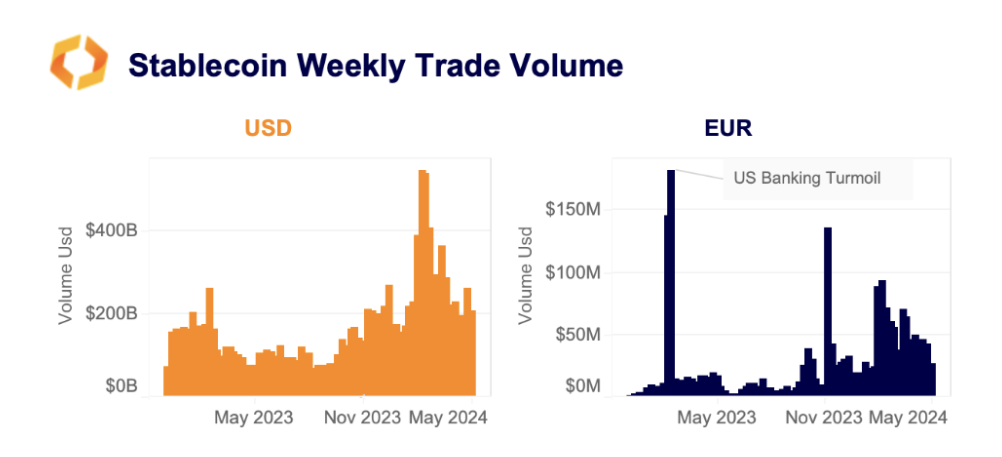
We remind you, however, that the road to competing with products indexed to the US dollar is still very long.
As of today, according to the data from The Block, 99.3% of the market share of Ethereum stablecoins is dominated by those in USD, while the respective currencies in EUR collect only 0.63%.
The euro remains the “second best choice” compared to others DECREE currencies outside of the dollar in this context, being the second most used currency in the stablecoin space.
Overall, the USD-backed stablecoin continues to dominate the cryptocurrency bull and bear market.
Nearly 90% of all crypto transactions are executed using US dollar-backed stablecoins against the US dollar.
Their average weekly volume in 2024 was $270 billion, 70 times higher than that of their EU counterparts.. On the contrary, only 1.1% of all transactions are carried out using euro-backed stablecoins.
However, it is worth noting that this share went from almost zero in 2020 and is currently at all-time highs.
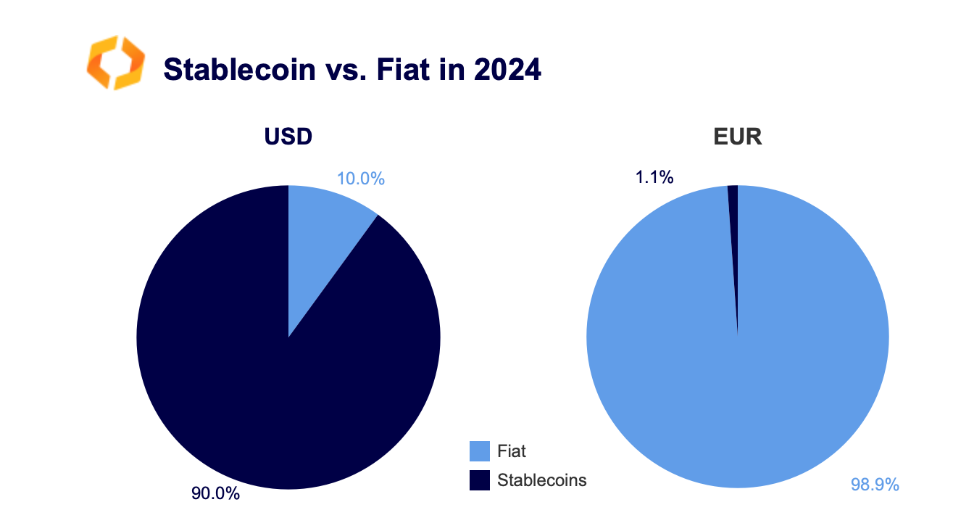
Although only time will tell if the introduction of Mica will push Euro-pegged stablecoins to compete with those overseas, in the meantime Experts already agree that the regulation is having a positive impact on the crypto sector even before it comes into effect.
For example, Dante Disparte, head of global policy at Circle, observed in an article on Capital risk investments in crypto projects on the continent increased almost 10-fold between 2022 and 2023, from 5.9% initially to 47.6%.
During the same period, the share of venture capital investments in the United States and Dubai declined significantly.
The MiCA effect
The share of venture capital investments in European crypto projects has increased almost 10-fold in one year – from a share of 5.9% in the first quarter of 2022 to 47.6% in the second quarter of 2023.
Regulatory clarity attracts capital and entrepreneurs from around the world. Great development for crypto in Europe! pic.twitter.com/kUVp3rwlg3
-Patrick Hansen (@paddi_hansen) May 9, 2023
Exchange, Tether and USDT: MiCA regulation becomes independent for Europe
Major crypto exchanges operating in Europe have already prepared for the regulatory earthquake that will soon be unleashed with MiCa.and proceeded to delist stablecoins deemed non-compliant with the regulations from their trading pairs.
Binance announced in this regard that it had differentiated its offer between stable coin “regulated” And “unauthorized»without however explicitly specifying which parts will be excluded for European customers.
What we know at the moment is that the launch pads of FDUSD will be suspended, and that USDT rewards for the “Spend to Earn” section will no longer be credited after June 29, with the exception of rewards accrued before this period: However, it is not clear whether USDT, which happens to be the stablecoin most affected by the new regulations, can still be traded on Binance’s spot and futures markets.
The OKX exchange, on the other hand, delisted USDT already in Marchwithout reference to the MiCa regulation but with obvious underlying links, while Kraken recently denied any similar delisting intentions.
Meanwhile, according to the latest crypto market news, the UpHold’s decision to delist 6 stablecoins on July 1, including USDT, DAI, FRAX, GUSD, USDP and TUSDexcluding USDC from the list, emerges.
Cryptocurrency exchange Uphold announced that due to MiCA in Europe on June 30, it will stop supporting several stablecoins, including Tether (USDT), Dai (DAI), Frax Protocol (FRAX), Gemini Dollar (GUSD), Pax Dollar (USDP). and TrueUSD (TUSD) starting July 1. They will be…
-Wu Blockchain (@WuBlockchain) June 18, 2024
MiCA’s optimism towards USD-pegged stablecoins, although motivated to leave room for EURO counterparts, could generate integration issues for European exchange clientswho still use USDT as their primary means of transitioning from FIAT to CRYPTO.
In fact, as data from Kaiko Research highlights, on both Binance and Kraken, the USDT-EUR pair proves to be a more traded instrument in terms of volumes than BTC-EURO, demonstrating that Tether’s currency represents an essential resource for European markets.
In such a context, although OTC exchanges will continue to provide USDT-EUR liquidity, many traders may choose to turn to regulated alternatives like USDC.
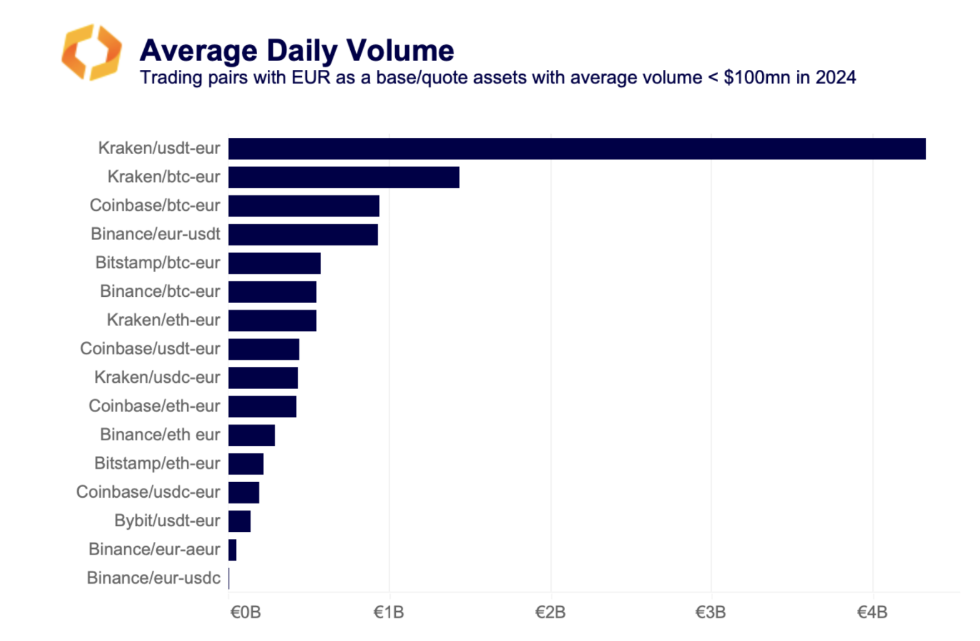 Source: https://research.kaiko.com/insights/what-mica-means-for-euro-stablecoins
Source: https://research.kaiko.com/insights/what-mica-means-for-euro-stablecoins
Paolo Ardoino, current CEO of Tether, has heavily criticized the next Mica regulation, highlighting how the obligation for issuers to hold at least 60% of their reserves in bank deposits constitutes a counter-effective measure in terms of security for the end customer.
In fact, the European Central Bank only insures bank deposits up to 100,000 euros, a figure significantly lower than USDT’s market capitalization of $112 billion.
Requiring issuers like Tether to build their reserves with simple bank deposits to comply with regulations provides a possible premise for one of the biggest financial disasters in the world of crypto finance in the event of a custodian bank collapse.
Recall that Tether currently holds reserves in cash and equivalents, US Treasury securities, precious metals, Bitcoin and other investments, offering a perfectly differentiated and weighted asset allocation according to the financial situation of the technology giant, which recorded profits of $4.5 billion in the first quarter of 2024.
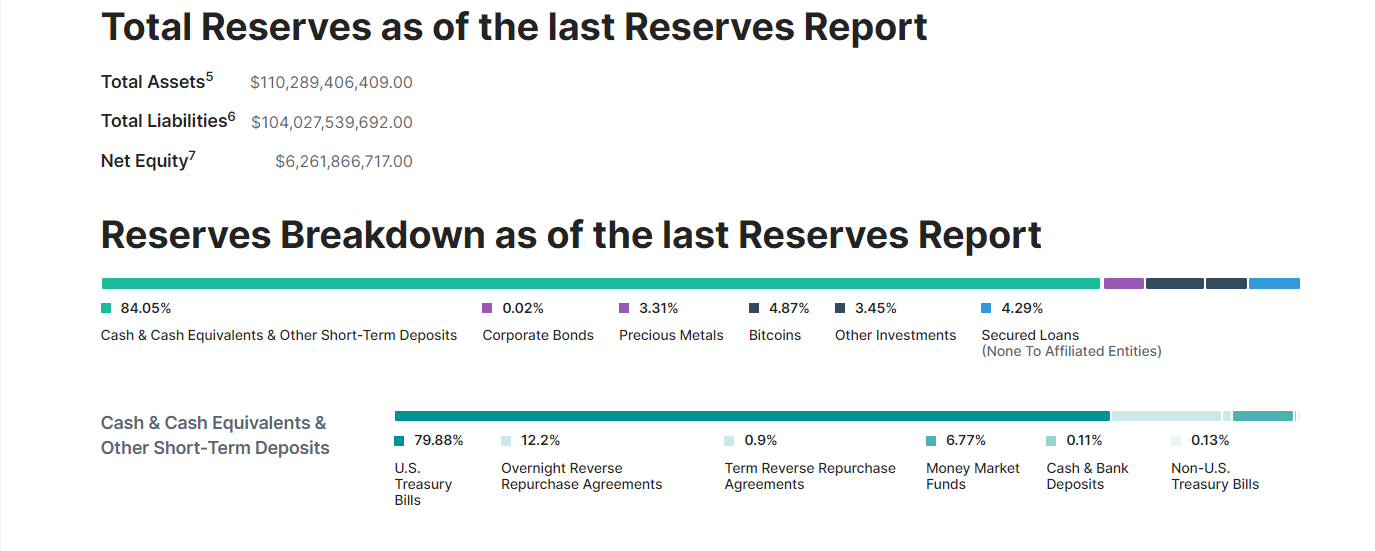 USDT Reserves. Source: https://tether.to/en/transparency/?tab=reports
USDT Reserves. Source: https://tether.to/en/transparency/?tab=reports
Fuente
Regulation
Crypto community gets involved in anti-government protests in Nigeria

Amid the #EndBadGovernanceInNigeria protests in Nigeria, a notable shift is occurring within the country’s cryptocurrency sector. As the general public demands sweeping governance reforms, crypto community leaders are seizing the opportunity to advocate for specific regulatory changes.
Rume Ophi, former secretary of the Blockchain Stakeholders Association of Nigeria (SiBAN), stressed the critical need to integrate crypto-focused demands into the broader agenda of the protests.
Ophi explained the dual benefit of such requirements, noting that proper regulation can spur substantial economic growth by attracting investors and creating job opportunities. Ophi noted, “Including calls for favorable crypto regulations is not just about the crypto community; it’s about leveraging these technologies to foster broader economic prosperity.”
Existing government efforts
In opposition to Ophi’s call for action, Chimezie Chuta, chair of the National Blockchain Policy Steering Committee, presents a different view. He pointed out The Nigerian government continued efforts to nurture the blockchain and cryptocurrency industries.
According to Chuta, the creation of a steering committee was essential to effectively address the needs of the crypto community.
Chuta also highlighted the creation of a subcommittee to harmonize regulations for virtual asset service providers (VASPs). With the aim of streamlining operations and providing clear regulatory direction, the initiative involves cooperation with major organizations including the Securities and Exchange Commission (SEC) and the Central Bank of Nigeria (CBN). “Our efforts should mitigate the need for protest as substantial progress is being made to address the needs of the crypto industry,” Chuta said.
A united call for support
The ongoing dialogue between the crypto community and government agencies reflects a complex landscape of negotiations and demands for progress.
While actors like Ophi are calling for more direct action and the inclusion of crypto demands in protest agendas, government figures like Chuta are advocating for recognition of the steps already taken.
As protests continue, the crypto community’s push for regulatory reform highlights a crucial aspect of Nigeria’s broader fight to improve governance and economic policies. Both sides agree that favorable regulations are critical to the successful adoption and implementation of blockchain technologies, signaling a potentially transformative era for Nigeria’s economic framework.
Read also : OKX Exchange Exits Nigerian Market Amid Regulatory Crackdown
Regulation
Cryptocurrency Regulations in Slovenia 2024
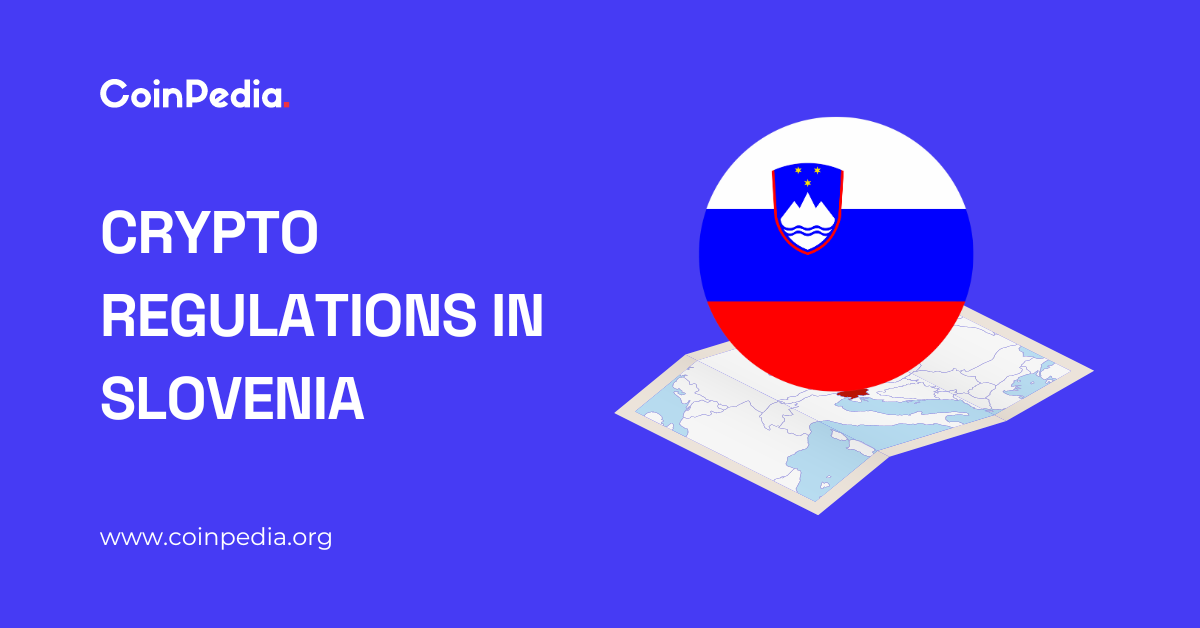
Slovenia, a small but highly developed European country with a population of 2.1 million, boasts a rich industrial history that has contributed greatly to its strong economy. As the most economically developed Slavic nation, Slovenia has grown steadily since adopting the euro in 2007. Its openness to innovation has been a key factor in its success in the industrial sector, making it a prime destination for cryptocurrency enthusiasts. Many believe that Slovenia is poised to become a powerful fintech hub in Europe. But does its current regulatory framework for cryptocurrencies support such aspirations?
Let’s explore Slovenia’s cryptocurrency regulations and see if they can propel the country to the forefront of the cryptocurrency landscape. My expectations are positive. What are yours? Before we answer, let’s dig a little deeper.
1. Cryptocurrency regulation in Slovenia: an overview
Slovenia is renowned for its innovation-friendly stance, providing a supportive environment for emerging technologies such as blockchain and cryptocurrencies. Under the Payment Services and Systems Act, cryptocurrencies are classified as virtual assets rather than financial or monetary instruments.
The regulation of the cryptocurrency sector in Slovenia is decentralized. Different authorities manage different aspects of the ecosystem. For example, the Bank of Slovenia and the Securities Market Agency oversee cryptocurrency transactions to ensure compliance with financial laws, including anti-money laundering (AML) and terrorist financing regulations. The Slovenian Act on the Prevention of Money Laundering and Terrorist Financing (ZPPDFT-2) incorporates the EU’s 5th Anti-Money Laundering Directive (5MLD) and aligns with the latest FATF recommendations. All virtual currency service providers must register with the Office of the Republic of Slovenia.
2. Cryptocurrency regulation in Slovenia: what’s new?
Several notable developments have taken place this year in the cryptocurrency sector in Slovenia:
July 25, 2024:Slovenia has issued a €30 million on-chain digital sovereign bond, the first of its kind in the EU, with a yield of 3.65%, maturing on 25 November 2024.
May 14, 2024:NiceHash has announced the first Slovenian Bitcoin-focused conference, NiceHashX, scheduled for November 8-9 in Maribor.
3. Explanation of the tax framework for cryptocurrencies in Slovenia
The Slovenian cryptocurrency tax framework provides clear guidelines for individuals and businesses. According to the Slovenian Financial Administration, the tax treatment depends on the status of the trader and the nature of the transaction.
- People:Income earned from cryptocurrencies through employment or ongoing business activities is subject to personal income tax. However, capital gains from transactions or market fluctuations are exempt from tax.
- Companies:Capital gains from cryptocurrency-related activities are subject to a 19% corporate tax. Value-added tax (VAT) generally applies at a rate of 22%, although cryptocurrency transactions that are considered as means of payment are exempt from VAT. Companies are not allowed to limit payment methods to cryptocurrencies alone. Tokens issued during ICOs must follow standard accounting rules and corporate tax law.
4. Cryptocurrency Mining in Slovenia: What You Need to Know
Cryptocurrency mining is not restricted in Slovenia, but income from mining is considered business income and is therefore taxable. This includes rewards from validating transactions and any additional income from mining operations. Both individuals and legal entities must comply with Slovenian tax regulations.
5. Timeline of the development of cryptocurrency regulation in Slovenia
Here is a timeline highlighting the evolution of cryptocurrency regulations in Slovenia:
- 2013:The Slovenian Financial Administration has issued guidelines stating that income from cryptocurrency transactions should be taxed.
- 2017:The Slovenian Financial Administration has provided more detailed guidelines on cryptocurrency taxation, depending on factors such as the status of the trader and the type of transaction.
- 2023:The EU adopted the Markets in Crypto-Assets (MiCA) Regulation, establishing a uniform regulatory framework for crypto-assets, their issuers and service providers across the EU.
Endnote
Slovenia’s approach to the cryptocurrency sector is commendable, reflecting its optimistic view of the future of cryptocurrencies. The country’s balanced regulatory framework supports cryptocurrency innovation while protecting users’ rights and preventing illegal activities. Recent developments demonstrate Slovenia’s commitment to continually improving its regulatory environment. Slovenia’s cryptocurrency regulatory framework sets a positive example for other nations navigating the evolving cryptocurrency landscape.
Read also : Hong Kong Cryptocurrency Regulations 2024
Regulation
A Blank Sheet for Cryptocurrencies: Kamala Harris’ Regulatory Opportunity

photo by Shubham Dhage on Unsplash
As the cryptocurrency landscape continues to evolve, the need for clear regulation has never been more pressing.
With Vice President Kamala Harris now leading the charge on digital asset regulation in the United States, this represents a unique opportunity to start fresh. This fresh start can foster innovation and protect consumers. It can also pave the way for widespread adoption across industries, including real estate agencies, healthcare providers, and online gaming platforms like these. online casinos ukAccording to experts at SafestCasinoSites, these platforms come with benefits such as bonus offers, a wide selection of games, and various payment methods. Ultimately, all this increase in adoption could propel the cryptocurrency market forward.
With this in mind, let’s look at the current state of cryptocurrency regulation in the United States, a complex and confusing landscape. Multiple agencies, including the Securities and Exchange Commission (SEC), the Commodity Futures Trading Commission (CFTC), and the Financial Crimes Enforcement Network (FinCEN), have overlapping jurisdictions, creating a fragmented regulatory environment. This lack of clarity has stifled innovation as companies are reluctant to invest in the United States, fearing regulatory repercussions. A coherent and clear regulatory framework is urgently needed to realize the full potential of cryptocurrencies in the United States.
While the US struggles to find its footing, other countries, such as Singapore and the UK, are actively looking into the cryptocurrency sector by adopting clear and supportive regulatory frameworks. This has led to a brain drain, with companies choosing to locate in more conducive environments.
Vice President Kamala Harris has a unique opportunity to change that narrative and start over. Regulation of cryptocurrencies. By taking a comprehensive and inclusive approach, it can help create a framework that balances consumer protection with innovation and growth. The time has come for clear and effective regulation of cryptocurrencies in the United States.
Effective regulation of digital assets is essential to foster a safe and innovative environment. The key principles guiding this regulation are clarity, innovation, global cooperation, consumer protection, and flexibility. Clear definitions and guidelines eliminate ambiguity while encouraging experimentation and development to ensure progress. Collaboration with international partners establishes consistent standards, preventing regulatory arbitrage. Strong safeguards protect consumers from fraud and market abuse, and adaptability allows for evolution in response to emerging trends and technologies, striking a balance between innovation and protection.
The benefits of effective cryptocurrency regulation are multiple and far-reaching. By establishing clear guidelines, governments can attract investors and mainstream users, driving growth and adoption. This can, in turn, position countries like the United States as global leaders in fintech and innovation. Strong safeguards will also increase consumer confidence in digital assets and related products, increasing economic activity.
A thriving crypto industry can contribute significantly to GDP and job creation, which has a positive impact on the overall economy. Furthermore, effective regulation has paved the way for the growth of many businesses such as tech startups, online casinos, and pharmaceutical companies, demonstrating that clear guidelines can open up new opportunities without stifling innovation. This is a great example of how regulation can allay fears of regressive policies, even if Kamala Harris does not repeal the current progressive approach. By adopting effective regulation, governments can create fertile ground for the crypto industry to thrive, thereby promoting progress and prosperity.
Regulation
South Korea Imposes New ‘Monitoring’ Fees on Cryptocurrency Exchanges

Big news! The latest regulatory changes in South Korea are expected to impact major cryptocurrency exchanges like Upbit and Bithumb. Under the updated regulations, these platforms will now have to pay monitoring fees, which could cause problems for some exchanges.
Overview of new fees
In the latest move to regulate cryptocurrencies, the Financial Services Commission announced on July 1 the revised “Enforcement Order of the Act on the Establishment of the Financial Services Commission, etc.” update “Regulations on the collection of contributions from financial institutions, etc.” According to local legislation newsThe regulations require virtual asset operators to pay supervisory fees for inspections conducted by the Financial Supervisory Service starting next year. The total fees for the four major exchanges are estimated at around 300 million won, or about $220,000.
Apportionment of costs
Upbit, which holds a dominant market share, is expected to bear more than 90% of the total fee, or about 272 million won ($199,592) based on its operating revenue. Bithumb will pay about 21.14 million won ($155,157), while Coinone and GOPAX will contribute about 6.03 million won ($4,422) and 830,000 won ($608), respectively. Korbit is excluded from this fee due to its lower operating revenue.
Impact on the industry
The supervision fee will function similarly to a quasi-tax for financial institutions subject to inspections by the Financial Supervisory Service. The new law requires any company with a turnover of 3 billion won or more to pay the fee.
In the past, fees for electronic financial companies and P2P investment firms were phased in over three years. However, the taxation of virtual asset operators has been accelerated, reflecting the rapid growth of the cryptocurrency market and increasing regulatory scrutiny.
Industry reactions
The rapid introduction of the fee was unexpected by some industry players, who had expected a delay. Financial Supervisory Service officials justified the decision by citing the creation of the body concerned and the costs already incurred.
While larger exchanges like Upbit and Bithumb can afford the cost, smaller exchanges like Coinone and GOPAX, which are currently operating at a loss, could face an additional financial burden. This is part of a broader trend of declining trading volumes for South Korean exchanges, which have seen a 30% drop since the new law went into effect.
-

 Regulation11 months ago
Regulation11 months agoRipple CTO and Cardano founder clash over XRP’s regulatory challenges ⋆ ZyCrypto
-

 Regulation10 months ago
Regulation10 months agoNancy Pelosi Considers Supporting Republican Crypto Bill FIT21 – London Business News
-

 Videos11 months ago
Videos11 months agoCryptocurrency News: Bitcoin, ETH ETF, AI Crypto Rally, AKT, TON & MORE!!
-

 Regulation11 months ago
Regulation11 months agoBitcoin’s future is ‘bleak’ and ripe for regulation, says lead developer
-

 News8 months ago
News8 months agoAave Price Increases Following Whales Accumulation and V3.1 Launch
-

 Regulation8 months ago
Regulation8 months agoSouth Korea Imposes New ‘Monitoring’ Fees on Cryptocurrency Exchanges
-

 Regulation8 months ago
Regulation8 months agoA Blank Sheet for Cryptocurrencies: Kamala Harris’ Regulatory Opportunity
-

 Regulation8 months ago
Regulation8 months agoCryptocurrency Regulations in Slovenia 2024
-

 News11 months ago
News11 months agoThe trader earned $46 million with PEPE after reaching a new ATH
-

 Regulation10 months ago
Regulation10 months agoCrypto needs regulation to thrive: Tyler Cowen
-

 Blockchain11 months ago
Blockchain11 months agoSolana ranks the fastest blockchain in the world, surpassing Ethereum, Polygon ⋆ ZyCrypto
-

 Blockchain10 months ago
Blockchain10 months agoSolana Surpasses Ethereum and Polygon as the Fastest Blockchain ⋆ ZyCrypto

















